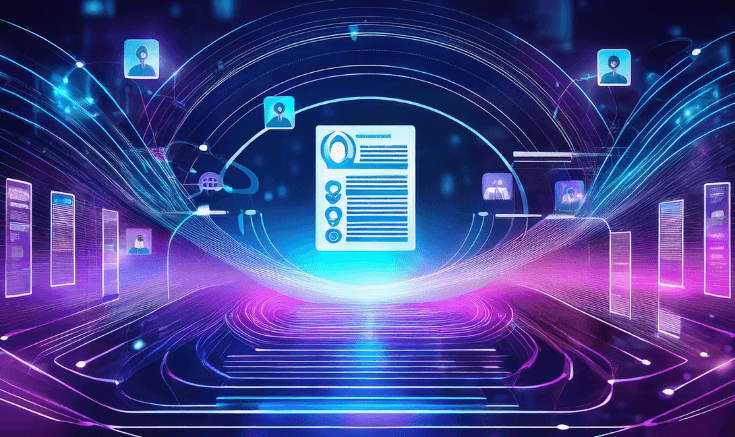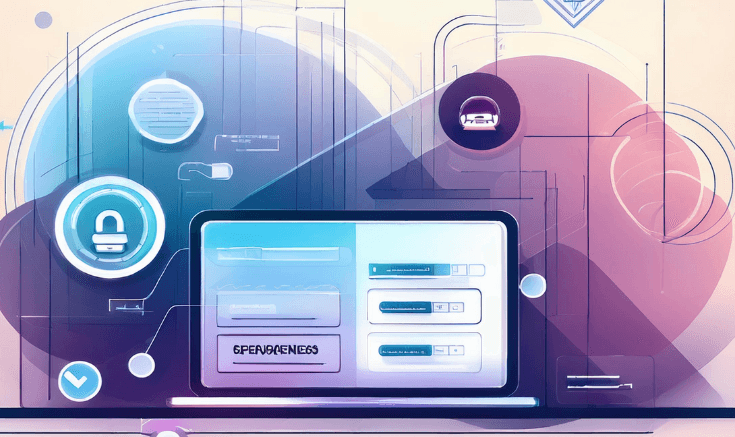

7 use cases of robotic process automation in HR
DEC. 29, 2024
6 Min Read
Efficient HR operations are critical to achieving organizational success, yet many processes remain burdened with inefficiencies and repetitive tasks.
Robotic process automation (RPA) offers a way to overcome these challenges by streamlining workflows, enhancing accuracy, and enabling HR teams to focus on what matters most—driving value through strategic initiatives. This transformative technology not only modernizes operations but also empowers businesses to stay agile and innovative.
Key takeaways
- 1. Robotic process automation reduces manual errors and increases efficiency in HR operations.
- 2. Automation enables scalable and compliant workflows, enhancing operational resilience.
- 3. Organizations benefit from real-time data processing and actionable insights through RPA.
- 4. HR teams can shift focus from repetitive tasks to strategic initiatives like talent development.
- 5. Employee experiences improve with faster processes and better access to HR services.
What is robotic process automation in HR?
Robotic process automation in HR refers to the use of advanced software tools to automate repetitive and rule-based tasks within human resources functions. This technology, known as RPA, helps HR teams save time and reduce manual errors by performing tasks like data entry, document management, and workflow processing with high efficiency and accuracy. RPA integrates seamlessly with existing systems, allowing it to mimic human actions without requiring major IT overhauls.
Adopting robotic process automation in human resources enables organizations to streamline processes such as payroll, recruiting, and compliance reporting. Unlike traditional methods that rely heavily on human intervention, RPA-led systems work 24/7, ensuring consistency and reducing bottlenecks in operations. Furthermore, this approach supports HR teams in reallocating their time toward strategic initiatives like talent development and employee engagement, creating measurable value for businesses.
Automating these routine processes enables RPA in HR to enhance operational efficiency and improve the employee experience. Employees benefit from faster responses to queries and requests, while organizations gain better data accuracy and real-time reporting capabilities, making it a powerful solution for HR transformation.
7 use cases of robotic process automation in HR
Robotic process automation in HR has greatly changed how organizations handle core human resources functions. Through this technology, businesses automate repetitive, time-intensive processes, enhancing both efficiency and accuracy. As businesses adapt to workforce demands, RPA empowers HR teams to lead with agility and innovation.
From managing data flows to ensuring timely payroll processing, automation becomes the cornerstone of a robust and scalable HR strategy. It’s a forward-thinking approach that equips companies to deliver measurable business impact while fostering a positive workplace culture.
1. Recruiting and hiring

Recruiting and hiring involve numerous repetitive tasks that are ideal for robotic process automation in HR. From screening resumes to scheduling interviews, RPA streamlines these steps, ensuring a smoother hiring process. Automation tools can quickly parse through thousands of applications, identifying candidates that match predefined criteria based on skills, experience, and qualifications. This reduces the time recruiters spend manually reviewing resumes.
RPA also manages communication during the hiring process. Automated emails update candidates about their application status or provide interview schedules. This consistency enhances the candidate experience while minimizing delays and errors. Beyond that, RPA supports data-led hiring by generating reports on metrics like time-to-hire or candidate drop-off rates, helping HR teams make informed improvements.
Implementing automation in recruiting and hiring increases efficiency and enhances accuracy. Recruiters can focus on high-value activities, such as engaging with top talent and building strong candidate relationships. For organizations, this results in better hires and shorter recruitment cycles.
2. Onboarding and training

Onboarding and training employees require careful coordination of tasks, from document collection to system access setup. RPA in HR simplifies these processes by automating the generation and distribution of onboarding documents. For instance, it can send employment contracts, tax forms, and policy manuals directly to new hires, ensuring all necessary paperwork is completed on time.
Automated workflows also assign system access rights and set up accounts across various tools based on role-specific requirements. Once onboarding is complete, RPA assists in training by delivering learning materials and tracking employee progress through learning management systems. It ensures employees receive timely reminders for mandatory training sessions, contributing to compliance and skill development.
Automation in onboarding and training significantly reduces administrative burdens, ensuring employees feel supported from their first day. Organizations benefit from consistent processes that enhance the onboarding experience and foster faster integration into the workplace.
3. Employee data management
Managing employee data involves maintaining accurate records, updating information, and ensuring compliance with data privacy regulations. RPA in HR automates these tasks, enabling seamless updates to employee profiles, payroll systems, and organizational charts whenever changes occur.
RPA can also reconcile discrepancies between HR systems, ensuring data consistency across platforms. For instance, if an employee updates their address in one system, automation ensures this change is reflected in all relevant databases. Additionally, it safeguards sensitive information by applying data protection protocols and ensuring compliance with regulations like GDPR or HIPAA.
Automation in employee data management ensures data accuracy, saves time, and reduces the risk of non-compliance. This approach allows HR teams to maintain trustworthy records that support better decisions and reporting.
4. Payroll management

Payroll is one of the most critical functions within HR, and even minor errors can have significant consequences. RPA enhances payroll accuracy by automating tasks such as calculating salaries, deductions, and bonuses. It verifies timesheets, applies tax rules, and ensures compliance with wage laws, all without manual intervention.
Additionally, automation tools manage payroll processing schedules, ensuring employees are paid on time. They can generate and distribute pay slips, process reimbursements, and handle tax filings efficiently. Any discrepancies flagged during payroll runs are highlighted for quick resolution, further ensuring accuracy and compliance.
Automating payroll reduces administrative overhead and improves employee satisfaction. Organizations build trust with their workforce by eliminating errors and delays and avoiding legal complications.
5. Attendance and absence management
Tracking employee attendance and managing leave requests are often time-consuming for HR teams. Robotic process automation in human resources handles these tasks by integrating with attendance systems to capture data and generate reports. It processes leave requests based on organizational policies and provides real-time updates on leave balances to employees.
Automation also flags attendance irregularities, helping managers address issues proactively. It can automatically update payroll systems with attendance data, ensuring accurate salary calculations without manual intervention.
Streamlining attendance and absence management through RPA ensures employees receive timely updates while reducing the workload on HR staff. This leads to better compliance with attendance policies and enhances workforce transparency.
6. Compliance and reporting

HR teams must navigate complex regulations and produce detailed reports to demonstrate compliance. RPA in HR simplifies these challenges by collecting, organizing, and analyzing data across systems. Automated tools generate compliance reports, track policy adherence, and provide audit trails for external reviews.
Automation also ensures that organizations remain updated with regulatory changes by flagging areas that need policy adjustments. Regardless of updating employee handbooks or maintaining accurate labor law records, RPA ensures compliance with minimal manual effort.
Employing automation for compliance reduces risks and enhances audit readiness. Organizations gain peace of mind knowing their practices align with the latest legal requirements.
7. Employee exit management
Handling employee exits involves several administrative steps, including collecting company property, revoking system access, and processing final payments. RPA automates these processes to ensure smooth offboarding. It generates exit documentation, schedules exit interviews and coordinates with IT to disable accounts.
Automation also calculates final settlements, including unused leave payouts or other benefits, ensuring timely and accurate payments. Furthermore, it updates organizational records to reflect the employee’s departure, maintaining data consistency.
Streamlined exit management enhances the departing employee’s experience and ensures compliance with company policies. Organizations benefit from a standardized process that reduces errors and minimizes disruption.
The applications of robotic process automation in human resources demonstrate its potential to transform every stage of the employee lifecycle. Organizations that invest in automation tools gain both efficiency and a competitive edge in attracting and retaining talent. Beyond operational benefits, RPA elevates the strategic role of HR, enabling teams to focus on building meaningful employee experiences and achieving broader business objectives.
As HR functions continue to evolve, automation offers a future-proof solution that delivers measurable outcomes. Either compliance assurance, seamless onboarding, or managing payroll with precision, RPA reshapes how HR operates. Embracing this technology ensures organizations remain agile, scalable, and well-equipped to meet both current and future challenges. The focus shifts from routine tasks to strategic leadership, creating a workplace that values innovation and efficiency.
“Automated workflows assign system access rights and set up accounts across tools, ensuring new hires are equipped to integrate quickly and effectively.”
Implementing RPA in HR
Successfully integrating robotic process automation into HR processes requires a structured approach that ensures alignment with business objectives and operational needs. While automation offers significant benefits, the implementation process involves strategic planning, technology selection, and team readiness. Organizations can optimize the results of RPA by considering these critical steps:
Assessing HR needs and identifying opportunities
The first step in implementing RPA in HR is understanding which processes would benefit most from automation. Tasks that are repetitive, high-volume, and rule-based are ideal candidates. Examples include payroll calculations, compliance reporting, and onboarding workflows. Conducting a detailed analysis of current operations helps identify inefficiencies and potential automation use cases.
Collaborating with HR teams ensures the selection of automation opportunities aligns with the department’s goals. Engaging employees during this phase also builds awareness and promotes adoption, fostering a smoother transition as new tools are introduced.
Selecting the right tools and technologies
Choosing an RPA platform involves evaluating factors like compatibility with existing systems, scalability, and user-friendliness. Many RPA tools offer pre-built integrations with popular HR management systems, making implementation more straightforward. Organizations should prioritize solutions that meet their specific needs while leaving room for future expansion.
Security is another key consideration. HR processes involve sensitive employee data, so robust encryption and compliance features are essential. Assessing vendor reliability and reviewing case studies or references provides confidence in the selected tool.
Building a cross-functional implementation team
A successful RPA implementation requires collaboration between HR, IT, and leadership. Cross-functional teams bring diverse perspectives, ensuring the automation strategy addresses technical, operational, and strategic needs. Designating clear roles and responsibilities helps streamline decisions and ensures accountability.
Providing adequate training ensures team members can manage and maintain automation tools. Establishing clear communication channels also facilitates feedback collection and helps address challenges effectively.
Testing, deployment, and scaling
Before full-scale deployment, pilot testing is essential. Running a controlled test on a single HR process allows organizations to validate the automation’s effectiveness, identify potential issues, and make adjustments. Once the pilot demonstrates success, scaling the solution across other processes ensures broader benefits.
Continuous monitoring and refinement are critical for maintaining RPA’s effectiveness. Regular updates to the system and process adjustments keep automation aligned with adjusting business needs and regulatory requirements.
Organizations that approach RPA implementation with a structured plan maximize the return on their investment while building an HR function that is efficient, scalable, and aligned with broader business goals.
Benefits of robotic process automation in HR
Integrating robotic process automation into HR creates opportunities to transform the way human resources departments operate. This approach minimizes inefficiencies while driving greater accuracy and scalability in core processes. For organizations aiming to enhance operational performance and achieve more with fewer resources, automation offers a proven way to align workforce management with strategic objectives. The focus shifts from manual, repetitive activities to meaningful contributions that improve both organizational outcomes and employee satisfaction.
Automation helps HR professionals streamline operations, ensuring compliance with regulatory requirements and providing insights that drive informed evaluation. The ability to scale processes and handle increased workloads without additional resources allows businesses to adapt to growth seamlessly. These outcomes create a more resilient and agile HR function capable of meeting the evolving demands of the modern workplace.
- Increased efficiency: Automation significantly reduces the time required to complete repetitive tasks such as data entry, payroll processing, and compliance reporting. This allows HR teams to focus on higher-value initiatives.
- Enhanced accuracy: Manual errors, especially in data-intensive processes, can lead to compliance risks and financial losses. RPA eliminates human error by consistently applying predefined rules across all tasks.
- Cost savings: Automating repetitive processes reduces labor costs and minimizes the resources needed for routine tasks. Over time, this creates significant cost efficiencies across the HR function.
- Improved compliance: Automation tools ensure that HR practices align with regulatory requirements by maintaining accurate records, generating reports, and flagging potential risks. This reduces the likelihood of non-compliance penalties.
- Scalability: As organizations grow, the volume of HR tasks increases. RPA scales effortlessly to handle growing demands without requiring additional staff or resources, ensuring consistent performance during periods of expansion.
- Faster decision-making: Real-time data processing and reporting enable HR teams to access actionable insights quickly. This supports better workforce planning and strategy execution.
- Enhanced employee experience: Automating administrative tasks allows HR teams to prioritize employee engagement and support. Employees benefit from faster responses to queries and a seamless experience in processes like onboarding and leave management.
Organizations that prioritize automation as part of their workforce strategy position themselves to succeed in industry markets. This technology empowers HR teams to act as strategic partners within the business, fostering better employee engagement and delivering measurable impact. The long-term effects include a more satisfied workforce, improved resource allocation, and the ability to adapt to changes with confidence. Transforming HR functions with automation establishes a foundation for sustainable growth and innovation across the enterprise.
“This technology enables organizations to streamline processes such as payroll, recruiting, and compliance reporting while improving data accuracy and consistency.”
How to measure RPA in HR success

Evaluating the success of robotic process automation in HR involves focusing on measurable outcomes that align with organizational goals. Metrics should assess both the operational impact of automation and its contribution to broader business objectives. A clear framework for measuring success ensures the benefits of automation are fully realized while identifying areas for continuous improvement.
One critical metric is process efficiency, which can be tracked by comparing the time taken to complete tasks before and after automation. Metrics such as error rates and compliance adherence also provide insights into how effectively automation is reducing risks and improving accuracy. Employee satisfaction surveys help gauge the impact of automation on HR service quality, while cost-benefit analyses provide a clear picture of the financial return on investment.
Incorporating real-time analytics allows organizations to monitor the performance of automated processes and quickly identify potential issues. Insights from this data can guide adjustments, ensuring automation continues to deliver value. When combined with qualitative feedback from HR teams and employees, these measurements create a comprehensive view of how automation is reshaping the HR function and driving organizational success.
Human resources automation is more than a tool for efficiency—it’s a pathway to unlocking strategic potential within your organization. By eliminating manual inefficiencies and fostering scalability, robotic process automation enables HR teams to focus on delivering measurable impact. At Lumenalta, we create tailored automation solutions designed to align with your goals, ensuring your business is prepared to lead.
Let’s light the way to smarter HR operations together.
table-of-contents
- What is robotic process automation in HR?
- 7 use cases of robotic process automation in HR
- 1. Recruiting and hiring
- 2. Onboarding and training
- 3. Employee data management
- 4. Payroll management
- 5. Attendance and absence management
- 6. Compliance and reporting
- 7. Employee exit management
- Implementing RPA in HR
- Benefits of robotic process automation in HR
- How to measure RPA in HR success
- Common questions about robotic process automation in HR
Common questions about robotic process automation in HR
What is the primary goal of robotic process automation in HR?
How does automation improve HR compliance?
What should organizations consider before implementing HR automation?
How does automation impact employee satisfaction?
Want to learn how robotic process automation can bring more transparency and trust to your operations?





